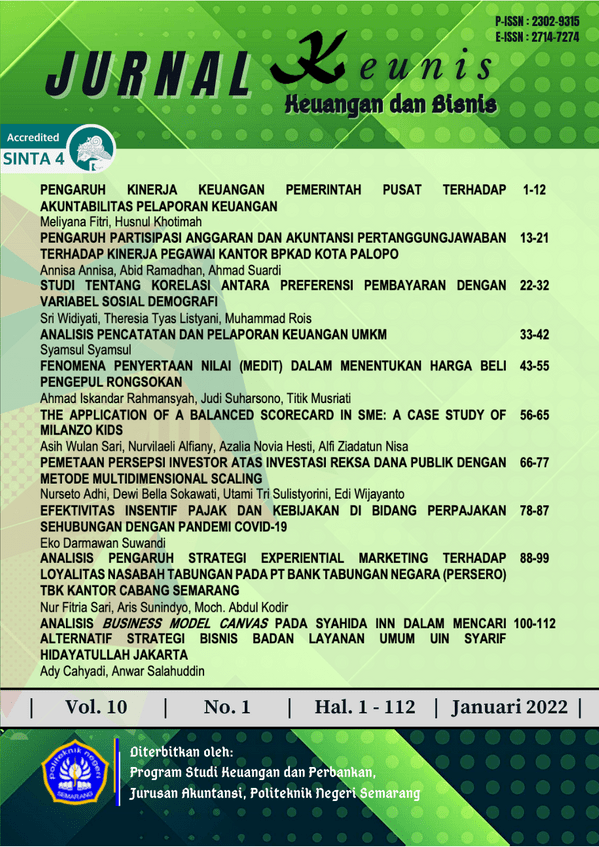STUDI TENTANG KORELASI ANTARA PREFERENSI PEMBAYARAN DENGAN VARIABEL SOSIAL DEMOGRAFI
DOI:
https://doi.org/10.32497/keunis.v10i1.3070Keywords:
preference, payment, e-money, demographic variablesAbstract
The era of digitalization is underway in Indonesia. One of the influential aspects is the business environment. In the business world, economic transaction are vital in developing a cashless society. The purposed of the study to assess the socio demographic variables (gender, marital status, education level, occupation dan income) correlate of the payments preferences. The sampling method was purposive sampling. An online survey of 100 participants was conducted among a sample of people who aged 20 years and over and have used e-money for three months. The survey included two parts: first, socio demographic characteristics and second the preferency of payments. Cross tabulation and Chi Squared test were used. The results showed that the majority participans was under 40 years old and have more one instruments of e-money. E-money used for on line shopping, transportation and to pay the bills. The conclution of the study there was no significant correlation between the preference of payment methods with socio demographic variables.
References
Ahsan Ridhoi, M. (2020). Mana yang Paling Favorit, E-Money atau E-Wallet? Katadata.Co.Id. https://katadata.co.id/muhammadridhoi/analisisdata/5f97c41b49705/mana-yang-paling-favorit-e-money-atau-e-wallet
Case, K. E. dan R. C. F. (2007). Prinsip-Prinsip Ekonomi (8th ed.). Erlangga. http://laser.umm.ac.id/catalog-detail-copy/130001448/
Dwi Wulandari, Thomas Soseco, B. S. N. (2016). Analysis of the Use of Electronic Money in Efforts to Support the Less Cash Society. International Finance and Banking, 3(1), 1”“10. https://www.macrothink.org/journal/index.php/ifb/article/view/8802/13079
Haque, A., Ulfy, M. A., & Anis, Z. (2020). Factors Influencing the Use of E-wallet as a Payment Method among Malaysian Young Adults. Journal of International Business and Management, 3(April), 1”“12. https://doi.org/10.37227/jibm-2020-2-21/
Jono M. Munandar, F. U. dan M. A. (2004). Analisis Faktor yang Mempengaruhi Preferensi Konsumen Produk Air Minum Dalam Kemasan di Bogor. Jurnal Teknologi Industri Pertanian, 13(3), 97”“107. https://journal.ipb.ac.id/index.php/jurnaltin/issue/view/683
Kalckreuth, U., & Stix, T. S. and H. (2009). Choosing and Using Payment Instruments (No. 1144). https://www.ecb.europa.eu/pub/pdf/scpwps/ecbwp1144.pdf
Kasthuri Subaramaniam, R. K., & Jalil, A. Bin. (2020). The Impact of E-Wallets for Current Generation. Jour of Adv Research in Dynamical & Control Systems, 12(01), 751”“758. https://www.researchgate.net/profile/Raenu-Kolandaisamy/publication/339236716_The_Impact_of_E-Wallets_for_Current_Generation/links/5e583914299bf1bdb840a5a9/The-Impact-of-E-Wallets-for-Current-Generation.pdf
Khanna, N. K. dan J. (2017). Cashless Payment : A Behavioural Change to Economic Growth. Qualitative and Quantitative Research Review, 2(2), 82”“102. https://nfct.co.uk/wp-content/uploads/journal/published_paper/volume-2/issue-2/LS0q4m3F.pdf
Liu Yang and Youtang Zhang. (2020). Digital Financial Inclusion and Sustainable Growth of Small and Micro Enterprises””Evidence Based on China”™s New Third Board Market Listed Companies. Sustainability, 12(9), 1”“21. https://www.mdpi.com/journal/sustainability
Nafisah Zahra dan Sanaji. (2021). Peran Moderasi Motivasi Hedonis pada Pengaruh Promosi Penjualan terhadap Niat Penggunaan Ulang Layanan Dompet Elektronik di Kalangan Milenial. Jurnal Ilmu Manajemen, 9(1), 57”“67. https://journal.unesa.ac.id/index.php/jim/article/view/9536/0
Nur Riyanto Al Arief. (2010). Ekonomi Mikro. Kencana.
Rana, S. S. (2017). A Study of Preference Towards The Mobile Wallets Among The University Students In Luckdown City. Scholedge International Journal of Management & Development, 4(6), 46”“57. www.theSCHOLEDGDE.org
Rosyidah Nur Islamiyah, Ima Amaliah, W. R. (2020). Preferensi Masyarakat Indonesia dalam Melakukan Transakasi Konsumsi dengan E-Wallet dan Tunai. Prosiding Ilmu Ekonomi, 103”“107. http://karyailmiah.unisba.ac.id/index.php/ekonomi/issue/view/260
Setiawan, S. R. D. (2013). Ini Tiga Keuntungan “Less Cash Society.” Kompas.Com. https://ekonomi.kompas.com/read/2013/12/16/1512136/Ini.Tiga.Keuntungan.Less.Cash.Society.
Setiawan,Kodrat.2021.BI.Transaksi Uang Elektronik Tumbuh 55,54 % Pada Oktober 2021. https://bisnis.tempo.co/read/1530093/bi-transaksi-uang-elektronik-tumbuh-5554-persen-pada-oktober-2021/full&view=ok
Stavins, J. (2016). The Effect of Demographics on Payment Behaviour : panel data With Sample Selection (No. 16”“5). https://econpapers.repec.org/paper/fipfedbwp/16-5.htm
Tbk, P. B. D. I. (2021). Pilih Uang Elektronik atau Dompet Digital ? Danamon.Co.Id. https://www.danamon.co.id/id/D-Bank/Artikel/Pilih-Uang-Elektronik-dan-Dompet-Digital
Uma Sekaran. (2006). Metodologi Penelitian Untuk Bisnis. Salemba Empat.
Yaokumah, W., Kumah, P., & Okai, E. S. A. (2017). Demographic Influences on E-Payment Services. International Journal of E-Business Research, 13(1). https://www.researchgate.net/publication/309352009_Demographic_Influences_on_E-Payment_Services
Downloads
Additional Files
Published
Issue
Section
License
KEUNIS is licensed under a Creative Commons Attribution-ShareAlike 4.0 International License.
Authors who publish with this journal agree to the following terms:
- Authors retain copyright and grant the journal right of first publication with the work simultaneously licensed under a Creative Commons Attribution-ShareAlike 4.0 International License that allows others to share the work with an acknowledgement of the work's authorship and initial publication in this journal.
- Authors are able to enter into separate, additional contractual arrangements for the non-exclusive distribution of the journal's published version of the work (e.g., post it to an institutional repository or publish it in a book), with an acknowledgement of its initial publication in this journal.
- Authors are permitted and encouraged to post their work online (e.g., in institutional repositories or on their website) prior to and during the submission process, as it can lead to productive exchanges, as well as earlier and greater citation of published work (See The Effect of Open Access).






